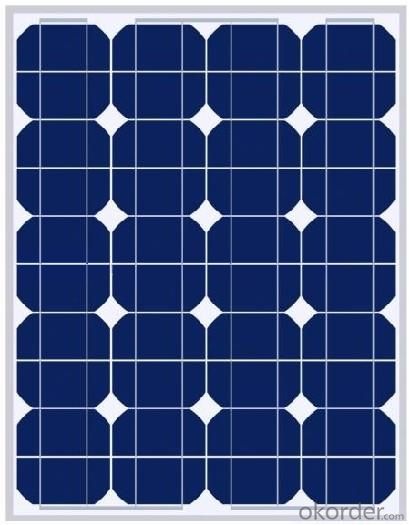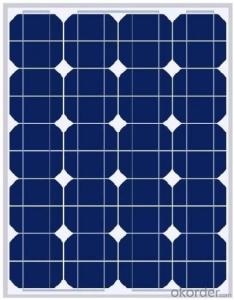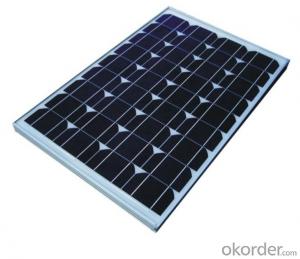Small Monocrystalline Solar Panel with 5W CNBM
- Loading Port:
- Qingdao
- Payment Terms:
- TT OR LC
- Min Order Qty:
- 10 set
- Supply Capability:
- 300000 set/month
OKorder Service Pledge
OKorder Financial Service
You Might Also Like
Small Monocrystalline Solar Panel with 5W


Quick Details
Place of Origin: | China (Mainland) | Brand Name: | CNBM | Model Number: | XRP-156M-250W |
Material: | Monocrystalline Silicon | Size: | 1620x992x40mm | Number of Cells: | 60 |
Max. Power: | 250w | Optimum Operating Voltage (Vmp): | 28.8V | Optimum Operating Current (Imp): | 8.68A |
Open Circuit Voltage (Voc): | 36V | Short Circuit Current (Isc): | 8.87A | Maximum Power at STC (Pmax): | 250W |
Operating Module Temperature: | -40 °C to +85 °C | Maximum System Voltage: | 1000 V DC (IEC) / 600V DC (UL) | Maximum Series Fuse Rating: | 15A |
Packaging & Delivery
Delivery Detail: | two weeks after order confirmation |
Features:
1) High Module conversion efficiency, through superior manufacturing technology
2) 0 to +5W positive tolerance for mainstream products
3) Certified to withstand high wind loads and snow loads
4) Anodized aluminum is for improving corrosion resistance
5) Anti-reflective, Highly transparent, low iron tempered glass
6) Excellent performance under low light environment
Benefit:
25-year performance warrant
10-year Product warranty
Electrical Characteristics:
Item No. | XRM-250W |
Optimum Operating Voltage (Vmp) | 28.8V |
Optimum Operating Current (Imp) | 8.68A |
Open Circuit Voltage (Voc) | 36V |
Short Circuit Current (Isc) | 8.87A |
Maximum Power at STC (Pmax) | 250W |
Cell Efficiency | 17.70% |
Operating Module Temperature | -40 °C to +85 °C |
Maximum System Voltage | 1000 V DC (IEC) / 600V DC (UL) |
Maximum Series Fuse Rating | 15A |
Power Tolerance | 0/+5 % |
STC: lrradiance 1000 W/m2, module temperature 25 °C, AM=1.5;
Best in Class AAA solar simulator (IEC 60904-9) used, power measurement uncertainty is within +/- 3%
Mechanical Characteristics:
No. of Cells | 60(6X10) |
Dimensions | 1640x992x40MM |
Weight | 20.0KGS |
Front | Glass 4.0 mm tempered glass |
Frame | Anodized aluminium alloy |
Temperature Characteristics:
Nominal Operating Cell Temperature (NOCT) | 45±2°C |
Temperature Coefficient of Pmax | -0.44 %/°C |
Temperature Coefficient of Voc | -0.33 %/°C |
Temperature Coefficient of Isc | 0.055 %/°C |
Refer to the Wmp range
Our factory can produce solar panel and solar module from 1.5W-290w (1.5w, 2.5w, 5w, 10w, 20w, 40w, 50w, 60w, 80w, 85w, 125w, 135w, 150w, 165w, 180w), according to customers requirement.
(A). Wmp range: 0.01W-6W, to be sealed with epoxy resin on PCB (printed circuit board), or to be sealed in plastic directly.
(B). Wmp range: 0.01W-15W, to be encapsulated with PET, on PCB (printed circuit board)
(C). Wmp range: 1W-60W, to be encapsulated with PET, on stainless steel, with holes for assembling purpose.
(D). Wmp range: 1W-290W, to be encapsulated with tempered glass, EVA, TPT, together with aluminium frame, junction box and (if necessary)diode and cable.
Refer to the material:
Monocrystalline solar cell or polycrystalline solar cell
Efficiency range 14%-17%, cell size 5/6.
- Q:What about sources for straight forward solar powered products? Excluding toys, garden frogs and outdoorpath lights I have found few useful items for the home. What I have found are solar panels for under $00 each, inverters, rechargeable indoor lights and a few camping/RV products that are interesting. It seems to me that these could help me start to wean the family off the power company. I can't afford to go cold turkey and cover my roof with solar panels and I don't think the HOA would allow me to even if I could. Is anyone using solar on a small scale?
- I okorder Hope this helps.
- Q:Alright my family and i are buying a new home in Bradford,Ontario, we we thinking about solar panels and had a couple questions:. how much are they each?2. how many will we need to power a single family home(4 ppl)3. where can we find them in ontario?4.how much money do they really save you?5.what kind of energy do they providfe you withand other basic info or a website i can check out would be great!thanks in advance!
- I have a system that was installed last year. I have 20 panels which provide me with about 75% of my electricity. I do use less electricity than the average home. I use an average of 45 kwh in the summer, my neighbor uses more than double that. I paid $26K for the system, but I got a $0K rebate from my utility and the US gives a fed. tax credit. I am saving about $2K per year, so it will take just over 6 years to break even. I also have what I think is called net metering, my utility allows my meter to run backwards when I generate more energy than I use, so pretty much the entire time the sun is out in the summer. Having energy efficient appliances, reducing standby energy and using conservative climate control really helps keep my usage down. Weather striping, insulation and clean well maintained systems all help as well.
- Q:I know there's different brands of solar panels and they cost different amounts.But if anyone know the average price of one solar panel could you help me out?Also could you please list the size of the solar panel.
- That okorder
- Q:How do solar panels affect the electricity bill?
- Solar panels can significantly reduce or even eliminate electricity bills by generating renewable energy from the sun, thereby reducing the reliance on grid-supplied electricity. When solar panels produce more energy than is consumed, excess energy can be fed back into the grid, resulting in credits or reducing future bills through net metering programs.
- Q:How can solar panels be integrated into building designs?
- Solar panels can be integrated into building designs by incorporating them into the structure or facade of the building. This can be done by installing solar panels on the roof, as awnings, or as part of the building's walls or windows. Additionally, innovative designs like solar shingles or solar glass can also seamlessly integrate solar panels into the overall aesthetics of the building.
- Q:Hi.How efficienent are solar panels? I mean, suppose we install a kw panel.. Wil it produce 5kw in 5 hours of good sun light?Or like if its 80 percent efficient, wil it produce 4kw and so on.Also, do the chinese solar panels give the same results as compared with panels from other countries?I live in india, so we get plenty of sunlight during the day.Thanks
- Panels okorder
- Q:I have a 2V .5W solar panel and I want to get a battery that can be charged by the solar panel that can then be used to power a 2V .5W fan. Ideally I want all the components to be connected and able to run without interaction. I have very little knowledge in regards to this field which is why I have come to yahoo answers. Any help would be greatly appreciated.
- Get the origanal specs and go from there as when it runs with orginal specs then the solar panel runs properly
- Q:OK, so if you put solar panels up on a roof, they are busy turning the sun's energy into electricity. So, does that mean the roof (and therefore the house/structure) stays cooler as well? Or does it still get hot, because . . . I dunno, maybe the panels don't convert all the energy, and the spillover still heats up the building.Any links or URLs to scientific answers would be appreciated, but I don't mind hearing from the Average Joe or (Joelle).
- I asked the same question once to a PV install during a seminar a few years back, and he explained the following: No, PV panels do not reflect or absorb much heat from going into the building below but there is a reason for this: PV panels that reflect / absorb heat produce less electricity. They are designed to Thermally Transparent. Even worse if installed incorrectly without a good angle and air gap to allow the heat to escape the panels will actually trap this heat and increase the interior temperature of the building below! Below is the scientific analysis that is quite verbose but has two nice graphs at the end. To summarize: Adding PV panels, at best, shaded the building enough to reduce the load of the interior A/C unit by .8 kWh/sq-m/year. The electricity generated by the panels was about 356 kWh/sq-m/year. You can see the big advantage of PV panels is to make power, not reflect heat. Proper insulation is much cheaper and will do a much better job. Don’t worry, I was shocked too, but like anything it makes sense after it is explained.
- Q:I have just made my first dolar panel 20 watts, charges my 27TMX Trojan battery perfectly. Now I am thinking to build more solar panels for a grid tie installation at my house, maybe 5 panels would do it, is this safe?
- Congratulations on your solar panel. It takes a lot of work to construct one. Tying to the electric grid requires permission from your power company, and conformance to local building codes. This generally means compliance with the National Electrical Code (NEC), meaning your panels must be UL (or similar rating from another standard) listed, for fire and electrical safety reasons. Homemade panels won't qualify, unfortunately. I really would discourage you from trying to do a jungle installation without permission, as the power distribution in a house is nothing to be trifled with. That would also likely void your homeowner's insurance, and give the bank a reason to call your mortgage, if you have these.
- Q:Are you a Solar Panel Specialist/Genius/Enthusiast?
- No, just an amateur. I guess that could be called an Enthusiast. I think most people find the topic somewhat interesting, some more than others. Why do you ask?
1. Manufacturer Overview |
|
|---|---|
| Location | |
| Year Established | |
| Annual Output Value | |
| Main Markets | |
| Company Certifications | |
2. Manufacturer Certificates |
|
|---|---|
| a) Certification Name | |
| Range | |
| Reference | |
| Validity Period | |
3. Manufacturer Capability |
|
|---|---|
| a)Trade Capacity | |
| Nearest Port | |
| Export Percentage | |
| No.of Employees in Trade Department | |
| Language Spoken: | |
| b)Factory Information | |
| Factory Size: | |
| No. of Production Lines | |
| Contract Manufacturing | |
| Product Price Range | |
Send your message to us
Small Monocrystalline Solar Panel with 5W CNBM
- Loading Port:
- Qingdao
- Payment Terms:
- TT OR LC
- Min Order Qty:
- 10 set
- Supply Capability:
- 300000 set/month
OKorder Service Pledge
OKorder Financial Service
Similar products
New products
Hot products
Hot Searches
Related keywords



























